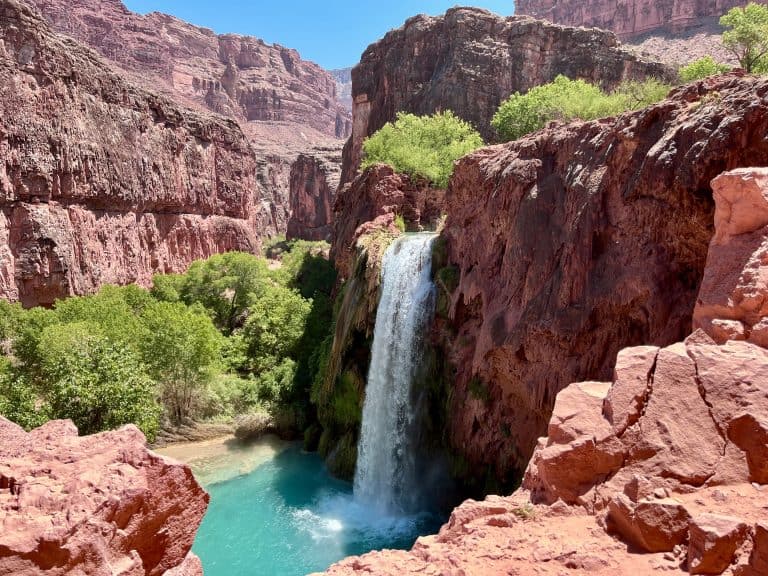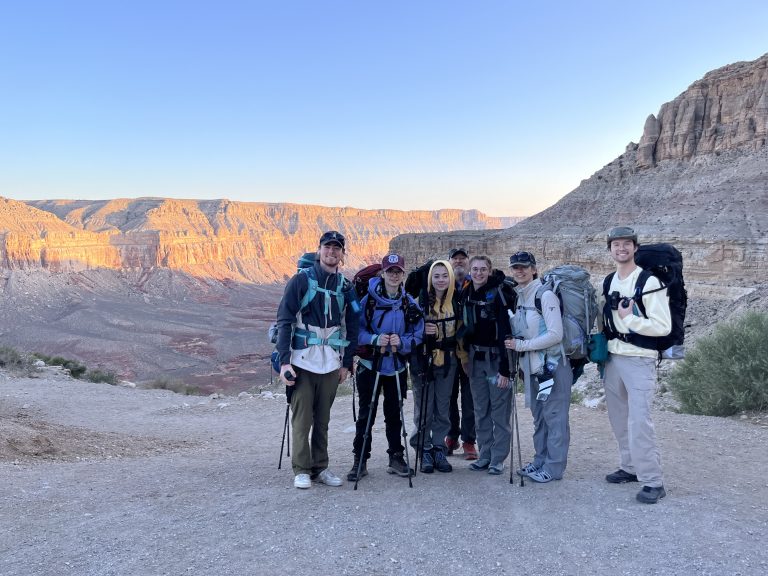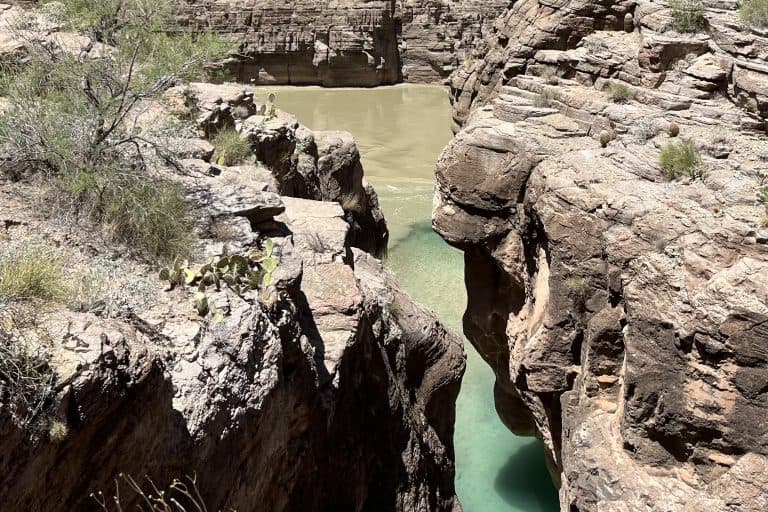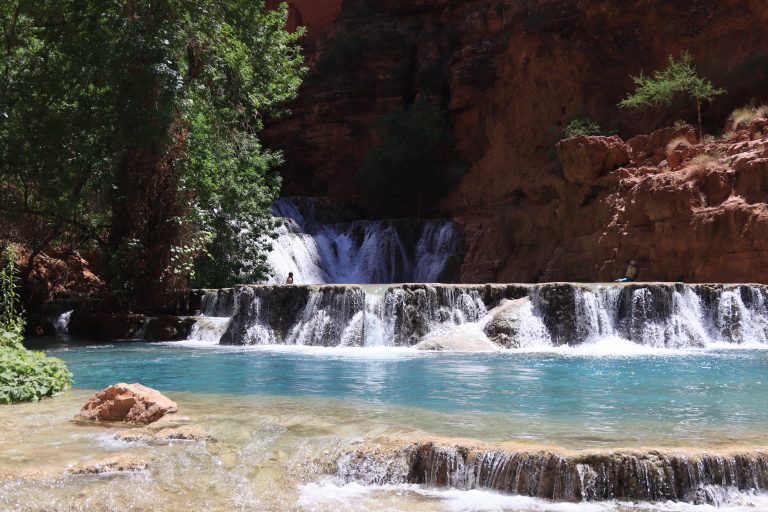Twenty-four hours before we reached our Havasupai check-in point, a deadly flash flood tore through the canyon. That close call changed how we approach flash flood safety and hiking— and it should change the way you do too.
In the August 2024 flood, a woman was swept away into the Colorado River and lost her life. Hundreds of others had their gear washed downstream and waited hours to be airlifted to safety. Many of them ended up at the same hotel we were staying at. We heard their stories firsthand. For the first time, flash floods were real to us, and we understood how serious the threat was.
Sure, we knew about flash floods before arriving. But it was like knowing about hurricanes while living in a landlocked Canadian province — something that happens to other people in faraway places. We never gave flash flood safety a second thought.
Eight months later, when we finally returned to hike the trail, everything had changed. Flash floods were always on our minds. Every trail, every turn, we were silently scanning for high ground and mentally mapping escape routes — even though it was the “safe season.”
What we didn’t know then? Just twelve days after we hiked out, another flood roared through the same canyon. It wasn’t deadly this time — but it was still dangerous, and still a reminder that flash floods don’t care what the calendar says.
Safe passage is never guaranteed on the trail. It’s our responsibility as hikers to be informed and prepared for the risks we may face — whether it’s a flash flood, a sudden snowstorm, or a wildlife encounter. The more we understand the dangers, the better we can mitigate them. Nature doesn’t hand out warnings — so we need to do the homework before we set foot on the trail.
Related Read: 👉🏼 A Complete Hiker’s Guide to Bear Safety: Lessons from the Trail
Related Read: 👉🏼 A Complete Guide to Rattlesnake Safety: Lessons From the Trail
Understanding Flash Floods
What Is a Flash Flood?
A flash flood is a sudden and intense flood that occurs with little or no warning, usually triggered by heavy rainfall or rapid snowmelt over a short period. These floods are especially common in areas with dry, compacted, or rocky terrainthat can’t absorb water quickly.
One of the most dangerous aspects of flash floods is that they can strike miles downstream from where the rain actually fell — meaning the sky may be clear overhead when the water rushes in. They typically last less than six hours, but they can be extremely destructive in that time.

Why They’re Especially Dangerous for Hikers
Flash floods are particularly hazardous for hikers because they often strike with little or no warning in remote areaswhere help is far away. The American Southwest, including places like Havasupai, Zion, and Escalante, is especially prone to them.
The very features that draw us in — stunning slot canyons, narrow gorges, and dry washes — can quickly become death traps during a flood. These natural corridors funnel rainwater into walls of rushing water, leaving little room to escape.
⚠️ Never try to outrun a flash flood.
The water moves faster than you can run — and it brings rocks, logs, and debris with it.
Trail Awareness: What to Watch for
When hiking in canyons or flash flood-prone areas like Havasupai or Zion being aware of your surroundings can save your life. Recognize the early warning signs and know how to respond if conditions change.
Signs a Flash Flood May Be Coming
Flash floods can occur without warning, especially if it’s raining miles upstream. Watch for these red flags even on sunny days.
If you see any of these signs take immediate action and move to higher ground:
- Distant thunder or rapidly darkening skies
Even if it’s sunny where you are, a storm miles upstream can send a wall of water your way. Thunder or storm clouds building in any direction, especially upstream must be taken seriously - Rain falling far upstream, even if skies are clear where you are
- A low, roaring sound echoing through the canyon
- Sudden Drop in Temperature or Gusty Winds
These are often the first signs of an approaching storm. Don’t wait to see rain — by then it may be too late. - Change in Water Flow or Color
If the creek suddenly starts rising, turns muddy, or carries debris like branches and logs, those are signs a flood surge is coming. - Weather Alerts or Radar Warnings
If you’re carrying a satellite communicator or have preloaded weather data, check regularly. Flash flood warnings require immediate action — do not second-guess them. - Trust Your Gut
Sometimes, your instincts know before your brain does.
If you feel uneasy or something just doesn’t sit right, don’t second-guess yourself. Never wait for visual confirmation of danger.
⚠️ Flash Flood Pro Tip:
If you’re hiking in a narrow canyon with limited exit points and even a small risk of rain exists upstream — don’t enter. Wait it out or save the hike for another day.
If You’re Caught in a Flash Flood
Flash floods can escalate in seconds. If water starts rising or flowing fast, act immediately to protect yourself.
Immediate Actions
Seconds matter — don’t hesitate if water starts to surge.
- Drop your pack if needed and climb to the highest ground possible
- Never try to outrun a flood in a narrow canyon — it moves faster than it appears
- Avoid crossing fast-moving water — even just 6 inches can knock you over
If You’re Swept Away
If you’re swept away by a fast-moving current, staying afloat and minimizing injury is all about body positioning, mental focus, and letting the current work for you rather than fighting it. Here are some tips to improve your chances of staying safe:
Body Position: Defensive Floating
- ✅ Float on your back
- Feet pointed downstream to help navigate around obstacles
- This helps you see what’s coming and use your legs to push off rocks or debris.
- ✅ Keep your hips high and your body flat on the surface of the water
- This reduces drag and helps you avoid getting snagged or pulled under.
- ✅ Arms out to your sides
- for balance and steering, like airplane wings.
- ❌ Do not try to stand– increases risk of drowning
- Standing in fast current increases the risk of foot entrapment in underwater rocks.
- Instead, stay horizontal and ride it out until you reach slower water or the bank.
Stay Calm and Conserve Energy
- ✅ Focus on controlling your breathing and keeping your head above water.
- ❌ Panic causes poor decisions and burns energy.
- ❌ Avoid grabbing at floating debris unless it’s stable and safe.
Use Your Surroundings
- ✅ Use your feet to gently push off rocks or walls if you’re headed toward them.
- ✅ Be cautious near strainers (obstacles like branches or logs) — they trap water and people.
- ✅ Aim for eddies (calm spots behind rocks or bend
- Be cautious near strainers (obstacles like branches or logs) — they trap water and people.
Post-Flood Hazards
Just because the water has stopped rushing doesn’t mean the danger is over. After a flash flood, the landscape can be unstable and unpredictable. Stay alert and assess your surroundings carefully. After the water recedes, dangerous conditions can still arise:
- ⚠️ Unstable trails, washed-out paths, and loose rock or mudslides may be left behind.
- ⚠️ Debris fields may block or conceal hazards on the trail.
- ⚠️ Increased risk of hypothermia if you’re soaked and exposed to wind or dropping temperatures.
- ⚠️ Watch for secondary surges — flash floods can come in waves hours apart, especially if upstream rainfall continues.
Planning Ahead: Prevention Is Survival
Before heading out on any hike — especially in remote or backcountry areas — take time to thoroughly research the trail and its conditions. Understanding the risks and how to prepare for them can make all the difference between a safe, enjoyable trip and a dangerous one.
Know the Terrain
- ✅ Check for current trail advisories
Consult official sources like park services or tribal offices for up-to-date information on trail closures, weather alerts, flash flood risks, or other hazards. - ✅ Understand the area’s history
Knowing past incidents (such as flash floods, rockfalls, or wildlife encounters) can help you prepare for similar risks. - ✅ Be aware of high-risk seasons
Certain times of year bring elevated dangers — like monsoon season, wildfire season, or extreme heat. Plan your trip accordingly and prepare for conditions that may shift quickly.
Check the Weather Before—and During—Your Hike
The National Weather Service (NWS) issues three main types of alerts. Understanding what they mean and how to respond to them is critical:
| Alert Type | What It Means | What You Should Do |
|---|---|---|
| Advisory | Hazardous weather is likely, but not life-threatening (yet). | Be aware, monitor conditions, and plan ahead. |
| Watch | Conditions are favorable for a hazardous event (e.g., flash flood, thunderstorm). | Stay alert. Be ready to act if the situation worsens. |
| Warning | A hazardous event is happening or imminent. | Take immediate action to protect life and property. |
🔴 Flash Flood Warning = Get to higher ground now.
🟡 Flash Flood Watch = Be alert; flooding could happen.
Where to Get Weather Alerts
Apps like MyRadar, AccuWeather, and Weather Underground are great with cell service. They deliver real-time warnings and storm tracking—but they do not work offline. Once you’re out of coverage, no new data will load.
📌 Pro Tip: For backcountry reliability, you’ll need a satellite communicator like Zoleo or Garmin inReach Mini 2
This post contains affiliate links, which means if you make a qualifying purchase after clicking one of my links, I may earn a small commission at no extra charge to you. I only recommend products we use and love or that I believe will add value to your trip. Thank you for supporting my blog.
ZOLEO Satellite Communicator
Buy at: REI | Amazon
Best for: 2-way messaging + weather in remote areas
- Uses Iridium satellites for global coverage
- Send/receive messages via ZOLEO app — works where phones don’t
- Manually request weather forecasts
- Get custom messages from someone monitoring NWS alerts
- Includes SOS feature for emergencies
- ❌ Does not automatically push NWS warnings
- ❌ Needs a phone for text messaging and weather updates
- ✅ Best if you want a durable, no-fuss communicator with shared access to NWS alerts via a home contact
Garmin inReach Mini 2
Buy at: REI | Amazon
Best for: Self-contained navigation + automated weather updates
- Global coverage via Iridium network
- Request weather forecasts, including premium pinpoint forecasts
- Optional automated NWS alerts (via third-party services or some subscriptions)
- 2-way messaging, SOS, tracking
- Syncs with Earthmate app for easier use
- ❌ More expensive
- ✅ Best if you want automated weather alerts, navigation, and advanced safety features
📌 Pro Tip: If you’re hiking in an area prone to flash floods, strongly consider investing in a satellite communication device. The ability to receive advanced weather alerts and send SOS signals can literally be life-saving.
For a long time, I assumed these devices were super expensive and didn’t even consider buying one. But once I actually looked into them and saw how affordable they really are, I knew it was time to invest in one before heading back to Havasupai. The Zoleo is now part of our essential gear.
What to Pack for Flash Flood Awareness
A satellite communicator, as mentioned earlier, is one of the most important tools you can carry in flash flood-prone areas — offering SOS capabilities and location sharing when cell service fails. But it shouldn’t be your only line of defense. The following gear can enhance your safety, communication, and ability to respond quickly if conditions suddenly change.
Essential Safety Gear
- Weather app with offline maps
- Like Gaia GPS
- 2-way radios for group communication
- These are a game changer if your group gets split up — especially in areas with no cell service. Use them to share real-time updates, give flash flood warnings, communicate your current location, or coordinate meeting points. Quick, clear communication can make all the difference in an emergency.
- Dry bag or waterproof phone case.
- Make sure your phone, satellite communicator and 2 way radios are protected from potential water damage. These items will be key for communication and navigation.
Optional But Smart
- Lightweight rope.
- Whistle and signal mirror.
⚠️ Trails with High Flash Flood Risk
American Southwest
1. The Narrows – Zion National Park, Utah
A slot canyon hike that literally follows the Virgin River. There’s no high ground for escape in many sections. Flash floods here can be deadly.
2. Buckskin Gulch – Paria Canyon, Utah/Arizona
One of the longest slot canyons in the world. It’s narrow, remote, and offers almost no exit points — even light rain miles away can be life-threatening.
3. Havasu Canyon (Havasupai Trail) – Arizona
From Supai Village to the Confluence, the trail follows Havasu Creek through steep canyon walls. Multiple past floods have impacted hikers — especially in monsoon season (July–September).
4. Antelope Canyon – Page, Arizona
This famous photo spot has had deadly flash floods in the past, even when the rain was far away. Entry is now controlled by guided tour only — and for good reason.
5. Orderville Canyon – Zion National Park, Utah
A tributary to the Narrows, it’s similarly risky with tight walls and frequent water flow — extremely vulnerable to rising water levels.
6. Peek-a-Boo and Spooky Gulch – Grand Staircase-Escalante, Utah
Two tight slot canyons known for their beauty and fun scrambles — but they’re notorious for flooding without warning due to poor drainage escape.
7. Kanarra Creek Canyon – Utah
Less crowded but still susceptible. This hike includes stream walking and canyon narrows, with no quick way out.
8. Willis Creek Slot Canyon – Utah
Though often dry, it can flood quickly when storms roll in. Its scenic, narrow passages make escape routes minimal.
Flash Flood Season
The Southwest U.S. monsoon season runs from mid-July through September, and this is typically when flash flood risk is highest. Sudden, intense thunderstorms can dump large amounts of rain in a short time, quickly overwhelming narrow canyons and dry creek beds.
However, flash floods can and do happen outside of this seasonal window. In fact, the most recent flood in Havasupai occurred on June 3, just after we finished our hike. This is a sobering reminder that:
✅ Even if the skies above are clear, rain upstream can still send a wall of water downstream.
✅ You should never rely solely on the calendar to assess flood risk.
✅ Always check the latest weather alerts and tribal or park service warnings before entering flood-prone areas.
Bottom line: If you’re hiking in canyon country, especially near creeks or narrow passages, treat flash flood awareness as a year-round necessity.
Areas Outside the American Southwest With Flash Flood Risk
Flash floods are a global hazard and can occur in many regions beyond the American Southwest, especially in mountainous or canyon-filled areas where storms can quickly channel water into narrow paths. Here are some notable regions where hikers face flash flood risk, even outside desert terrain:
🏔️ Himalayas (Nepal, India, Bhutan)
- Why: Steep terrain, glacial melt, and monsoons create sudden surges.
- Known For: Landslide-triggered flash floods and glacier lake outburst floods (GLOFs).
🌄 European Alps (France, Italy, Switzerland, Austria)
- Why: Thunderstorms in summer can drop heavy rain on high slopes.
- Watch For: Steep gorges, narrow valleys, and fast runoff into populated paths.
🌲 Pacific Northwest (Washington, Oregon, British Columbia)
- Why: Heavy rain, snowmelt, and steep terrain, especially in volcanic regions.
- Notable Areas: Mt. Rainier, Olympic Peninsula, Columbia River Gorge.
⛰️ Rocky Mountains (Colorado, Montana, Alberta)
- Why: Summer thunderstorms + steep canyons = sudden flash floods.
- Example: Big Thompson Canyon flood (1976, CO) is one of the deadliest in U.S. history.
🌧️ Blue Ridge & Smoky Mountains (Tennessee, North Carolina, Virginia)
- Why: High rainfall and steep terrain create runoff dangers.
- Watch For: Flash flooding in gorges and trails near creeks after storms.
🌴 Hawaii
- Why: Tropical storms and constant elevation change cause rapid runoff.
- High-Risk Trails: Hanakapiai Trail (Kauai), Manoa Falls (Oahu).
🌾 New Zealand (Southern Alps)
- Why: Intense rain events, especially on the West Coast.
- Watch For: Narrow valleys and creeks on popular tramping routes like the Milford and Routeburn Tracks.
🐾 Patagonia (Argentina and Chile)
- Why: Harsh weather systems can dump rain or snow suddenly.
- Risk Zones: Torres del Paine National Park, Fitz Roy region.
🐍 Southeast Asia (Thailand, Vietnam, Laos)
- Why: Monsoon rains + limestone karst terrain = quick runoff and flooding in caves and gorges.
⚠️ Key Takeaway:
Flash floods are not just a desert issue — any trail in a narrow valley, slot canyon, or below steep slopes can be at risk. Always check local weather and trail conditions, especially in areas with:
- Recent heavy rainfall or storms
- Snowmelt or tropical systems
- Steep, confined terrain
Flash Flood Safety Wrap UP
By the grace of God, we barely missed the flood last year. We had neither the gear nor the knowledge necessary to make informed choices if we had been there. We knew it was monsoon season; we knew flash floods were a risk. But we didn’t take the time to properly educate ourselves about the dangers or how to prepare for them.
The trail demands respect. Every trail has inherent risks, and we need to understand and prepare for them before we head out. Safety requires humility — and the awareness that yes, it can happen to us.
Fortunately, knowledge is power — and it’s the key to safely enjoying the power, majesty, and beauty of the world we’re blessed to explore. With proper preparation, research, and gear, we can reduce the risks and increase the chances of a safe, unforgettable adventure.





